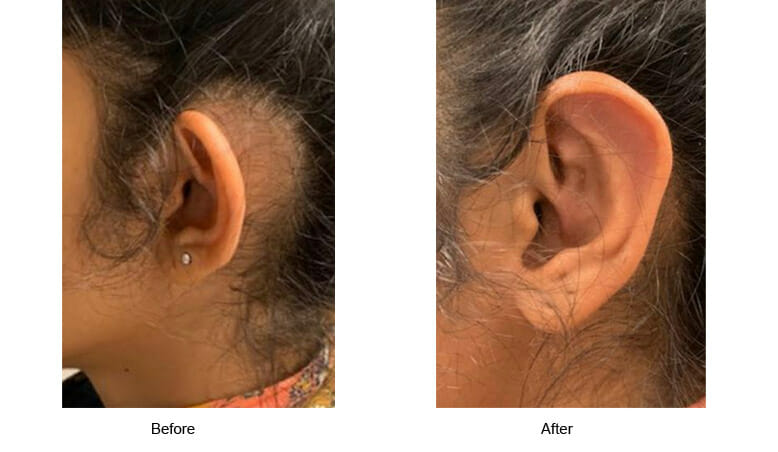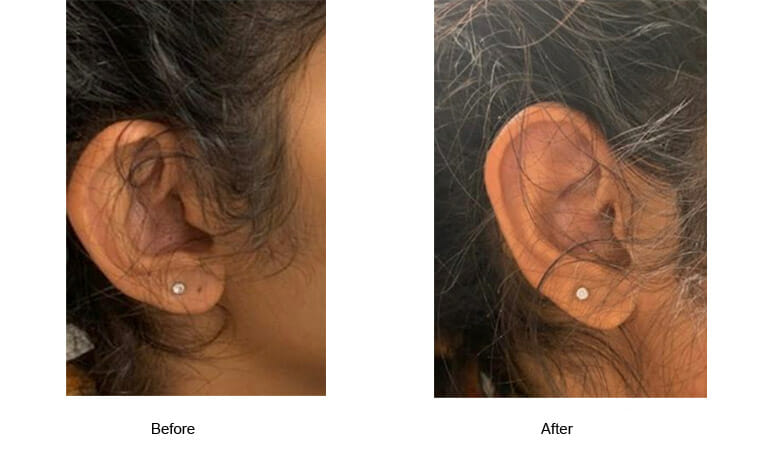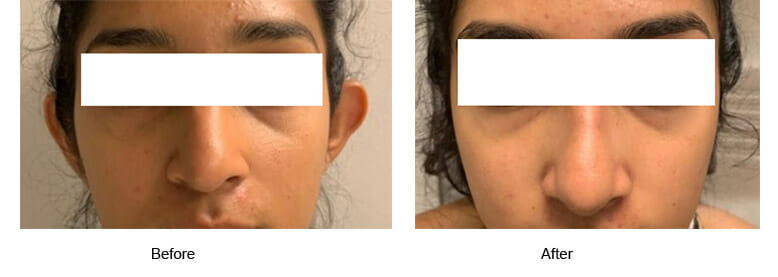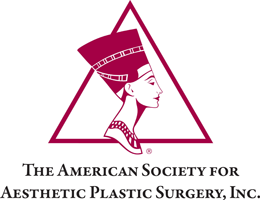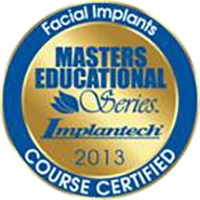
- About Ear Surgery
- Before & After
- Are you a Candidate?
- About the Operation
- What to Expect after the Surgery
- Your Recovery
- Possible Complications
About Ear Surgery
Ear surgery, or otoplasty, is normally performed to set prominent ears closer to the head or to reduce the size of large ears. Besides protruding or overly large ears, there are a variety of other ear problems that can be helped with the surgery including the following:
- “Lop ear,” which is when the tip seems to fold down and forward*
- “Cupped ear,” which is usually a very small ear*
- “Shell ear,” when the curve in the outer rim, as well as the natural folds and creases, are missing*
Surgery may also improve oversized, stretched earlobes or earlobes with large creases and wrinkles in them. In addition, people who were born without ears or who have lost them through an injury can have new ears built for them.*
Before and After
*Individual results will vary in each patient.
Are You a Candidate for Ear Surgery?
For the most part, this operation is done on children between the ages of four and fourteen. Ears are almost fully grown by the age of five. For children with protruding or overly large ears, the earlier the surgery, the less likely the child will have to endure teasing and ridicule. Ear surgery can also be performed on adults, and in most cases, there are generally minimal risks associated with ear surgery on an older patient.*
At the time of your consultation, Dr. Javaheri will ask about your child’s general medical history, or if the surgery is for you, your general medical history, specifically pertaining to any medical conditions that could cause problems during or after your surgery. These include uncontrolled high blood pressure, blood clotting problems, and a tendency to form excessive scars.*
About the Operation
Ear surgery normally takes approximately two to three hours, although some more complicated procedures may take longer.Ear surgery is usually performed on an outpatient procedure basis, although in some cases Dr. Javaheri may recommend that the procedure be done on an inpatient basis, requiring the patient to stay overnight in the hospital.*
If your child is young, Dr. Javaheri may recommend general anesthesia. For older children and adult patients, a local anesthetic combined with a sedative may be recommended to help the patient relax during the procedure.*
For most procedures, Dr. Javaheri will make a small incision in the back of the ear to expose the ear cartilage. He will then sculpt the cartilage and bend it back toward the head. Non-removable stitches may be used to help maintain the new shape.Occasionally, depending on the patient, Dr. Javaheri will extract a larger piece of cartilage to provide a more natural-looking fold when the surgery is complete.*
Another technique involves a similar incision in the back of the ear. Skin is reduced and stitches are used to fold the cartilage back on itself to reshape the ear without extracting any cartilage.
In most cases, a faint scar in the back of the ear will result, though it should fade with time. Even when only one ear appears to protrude, surgery is usually performed on both ears to ensure a better visual balance.*
What to Expect After the Surgery
Adults and children are both usually up and about within a few hours of surgery. The patient’s head will be wrapped in a bandage following surgery to promote the most optimal ear shaping and healing. The ears may throb or ache for several days, andthis can be treated with a mild pain medication.
Within a few days, the bulky bandages will be replaced by a lighter head dressing similar to a headband. The stitches are usually extracted or will dissolve on their own in approximately one week.*
Your Recovery
Most adults can go back to work about five days after surgery. Children can go back to school about one week after surgery. It is recommended that you allow for one week of rest.*
You will need to avoid any activity that could cause any harm to your or your child’s ears for at least two weeks. More active sports, particularly ball sports, should be avoided for four to six weeks.
As with any cosmetic procedure, there will be some scarring. These scars can take many months or even years to heal. You should expect the scars to be red, raised, lumpy, and even itchy to begin with. They should fade and flatten with time, as this is part of the healing process; please keep in mind that it may take up to two years for this process to complete.*
Possible Complications
Individuals vary greatly in their anatomy, their physical reactions, and their healing abilities, and the outcome is never completely predictable. As with any surgical procedure, the risk of infection is always a possibility. This can be minimized by the preventative administration of antibiotics both at the time of your surgery and after while in recovery. However, on occasion, mild infection can occur and is relatively common, although it usually subsides after two weeks.*
Complications are infrequent and usually minor for ear surgery. A small percentage of patients may develop a blood clot in the ear. It usually dissolves naturally or can be drawn out with a needle. Also, there is an incidence of recurrence which may require a secondary procedure(s).*
*Results for each patient will vary. Please remember that the information provided will not guarantee your eligibility for treatment. Consultation and medical examination must be completed before approval.
